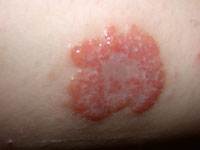DISCOID ECZEMA

Discoid eczema, also called nummular eczema or gravitational eczema is a coin shape patch of eczema that looks similar to ringworms as both are round. Adults mostly have discoid eczema on their legs and abdomen, chest and back and lower legs. Safflower oil can be a perfect low cost natural oil found in many grocery stores that is most identical to natural body oil. It can be considered as an adult form of atopic eczema. It can be complicated by a bacterial infection which causes weeping and crusting.
If you have had problems in finding a good solution, the best Discoid Eczema treatment would be Eczema-Ltd III to solve your eczema problem without risk with their 100% refund when returned within 120 days.
The word "nummular" comes from the Latin nummus, meaning coin, and is characterized by round plaques of eczema. Eruptions of nummular eczema are often recurrent and chronic and usually appear in people who are in their 60s but can occur at any age. Many have found relief during the late fall and winter by drinking more water. The average range for an adult should be 10 to 16 eight ounce glasses per day. Now you can imagine why many discoid eczema patients have more severe symptoms during the winter when the air is cold with a very low humidity. Mental stress as well as physical fatigue can also be a cause for discoid eczema.
The below also may aggrate discoid eczema during many seasons of the year:
- Fabric softeners
- Allergies
- Detergents,solvents & soaps
- Clothes made from wool
- Too frequent baths
Nummular eczema most commonly appears on the arms, back, buttocks, and lower legs that may be crusted, scaling, and extremely itchy. Neurodermatitis most commonly appears as scaly patches of skin on the head, lower legs, wrists, or forearms caused by a localized itch that becomes intensely irritated when scratched. A break in the skin may be the irritant that causes nummular eczema to start. The skin break can be a slight trauma or an insect bite.
Discoid eczema is most commonly found on the lower leg but has no boundaries. It may be termed 'varicose eczema' when it runs along the leg veins and result in gravitational eczema. Soon after the appearance of one or more discoid eczema patches,other patches may also appear. Sometimes the patches can last from a 10 days to several months. The size can range from 1/2 inch to an inch or more in size. The discoid eczema patches of skin are usually dry and inflamed and with marks sometimes being left from the inflammation after the skin heals. Discoid eczema is not a hereditary trait unlike atopic dermatitis. Sometimes areas of inflammation can become infected and medical attention many be needed.
As this type of eczema often starts off as a minor skin injury, always think to try to protect all exposed areas by clothing, gloves or masks from any thing that can affect the skin. Some common irritants are abrasion by friction, common harsh soaps or chemical solvents.
An eruption may begin with one or numerous round red plaques with tiny overlying blisters. The plaques often enlarge to several centimeters with clearly marked edges, and overlying scale may be prominent. Swelling and oozing occur in newer lesions and itching can be mild to severe.
Coal-tar salves can help relieve symptoms of nummular dermatitis that have not responded to other treatments, but these ointments have an unpleasant odor and stain clothing. Antibiotics can suppress the symptoms while in use, but sometimes the nummular dermatitis reappears later.
